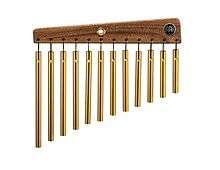Mark tree

A mark tree (also known as a chime tree or set of bar chimes) is a percussion instrument used primarily for musical colour. It consists of many small chimes – typically cylinders of solid metal approximately 6 mm (one-quarter inch) in diameter – of varying lengths mounted hanging from a bar. The chimes are played by sweeping a finger or stick through the length of the hanging chimes. They are mounted in pitch order to produce rising or falling glissandos.
Unlike tubular bells, another form of chime, the chimes on a mark tree do not produce a definite pitch, as they produce inharmonic (rather than harmonic) spectra.
The mark tree is named after its inventor, studio percussionist Mark Stevens. He devised the instrument in 1967. When he could not come up with a name, percussionist Emil Richards dubbed the instrument the mark tree.
The mark tree should not be confused with two similar instruments:
- Wind chimes are mounted in a circle with a hanging beater strung in the center; they may be solid or hollow and made of many types of material, whereas the mark tree is mounted in a linear fashion and normally has solid metal bars.
- The bell tree is a set of graduated cup-shaped bells mounted vertically along a center post.
See also
| Wikimedia Commons has media related to Mark trees. |
References
- Kalani (2008). All about Hand Percussion: Everything You Need to Know to Start Playing Now!. Alfred Music Publishing. pp. 24–. ISBN 978-0-7390-4964-8.